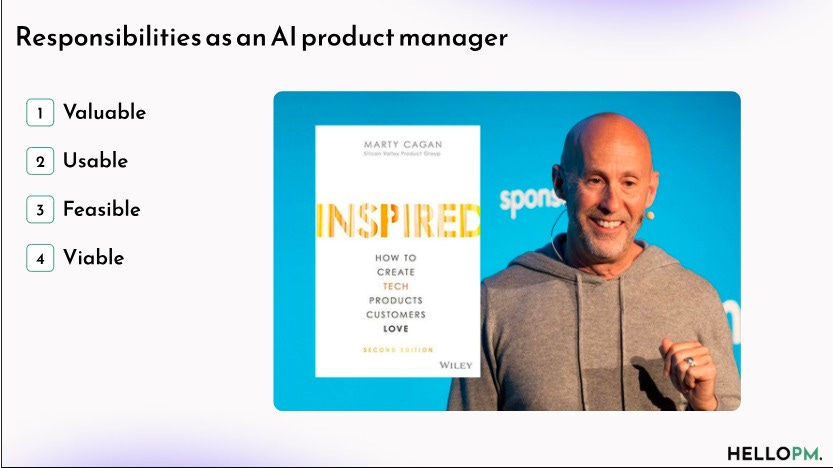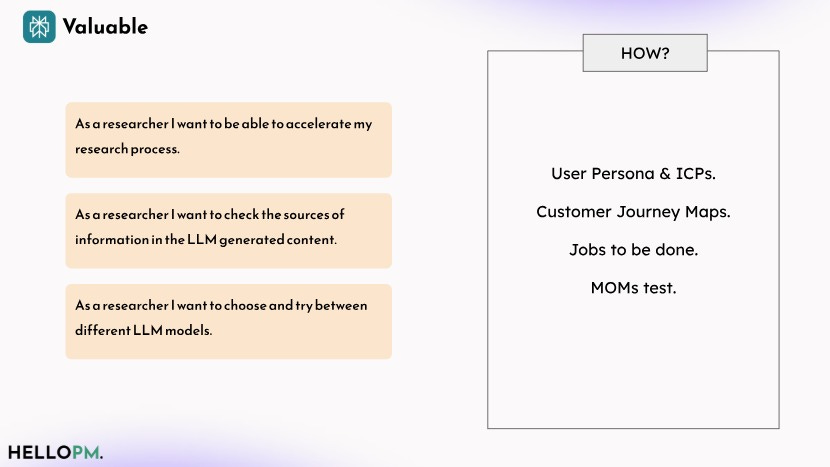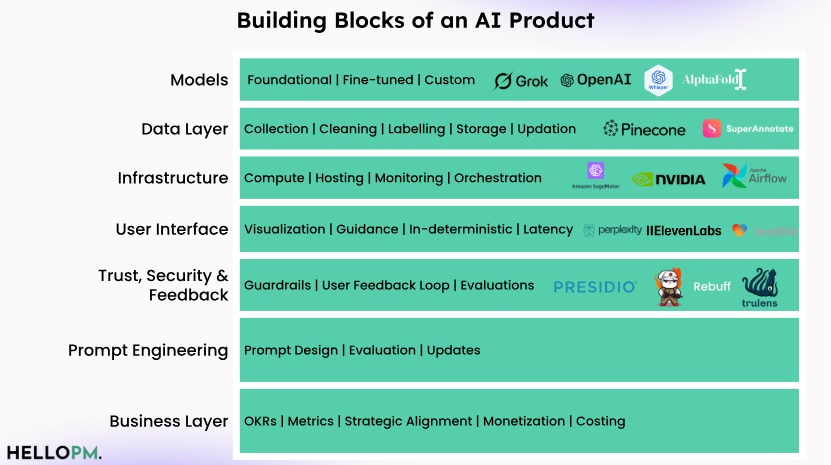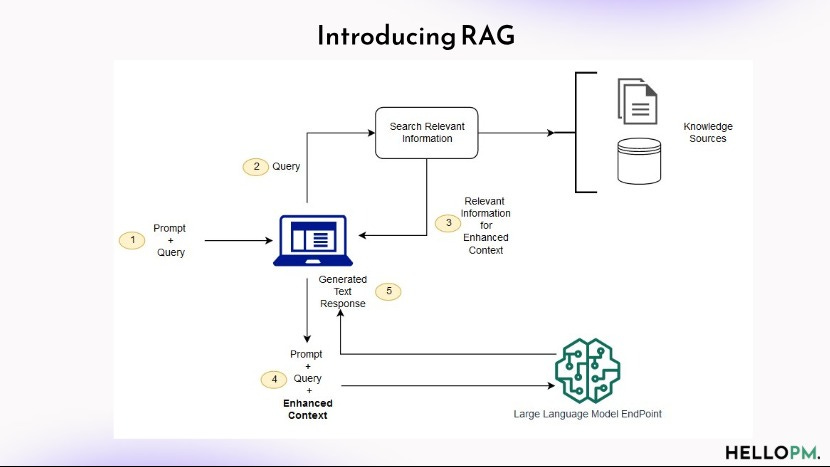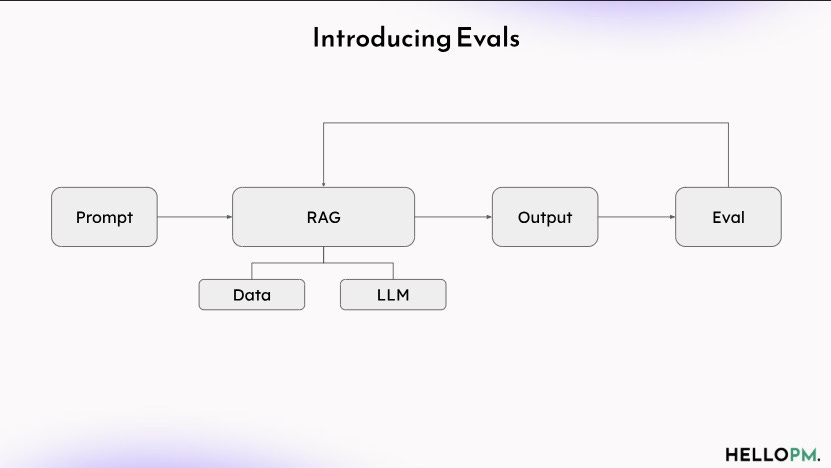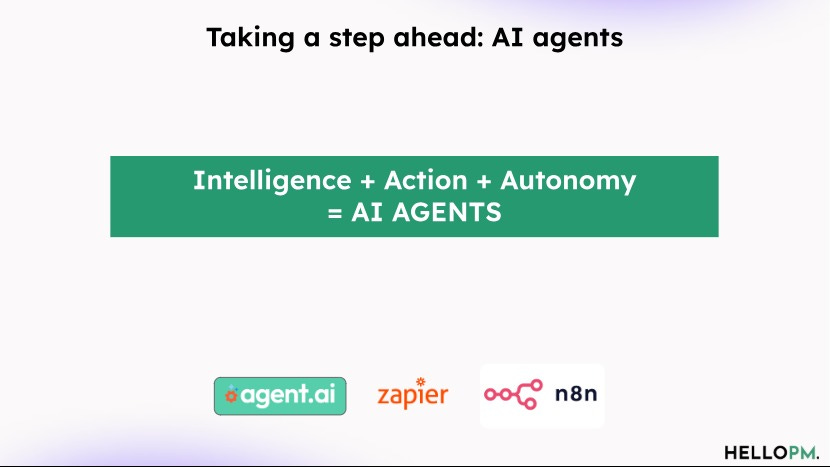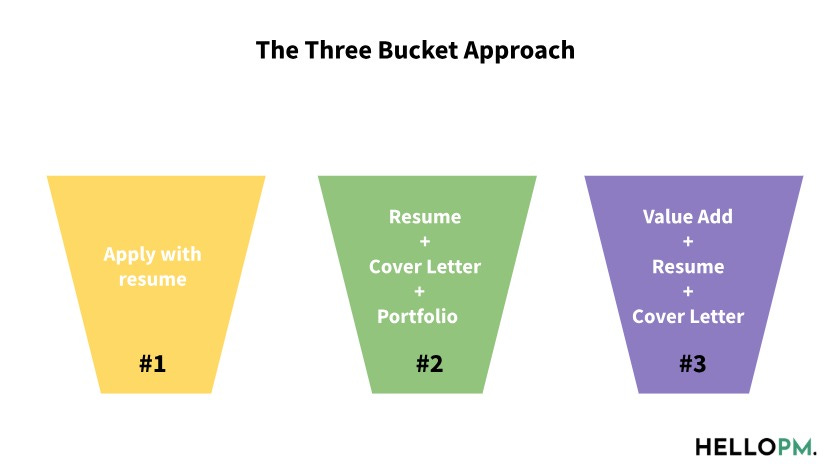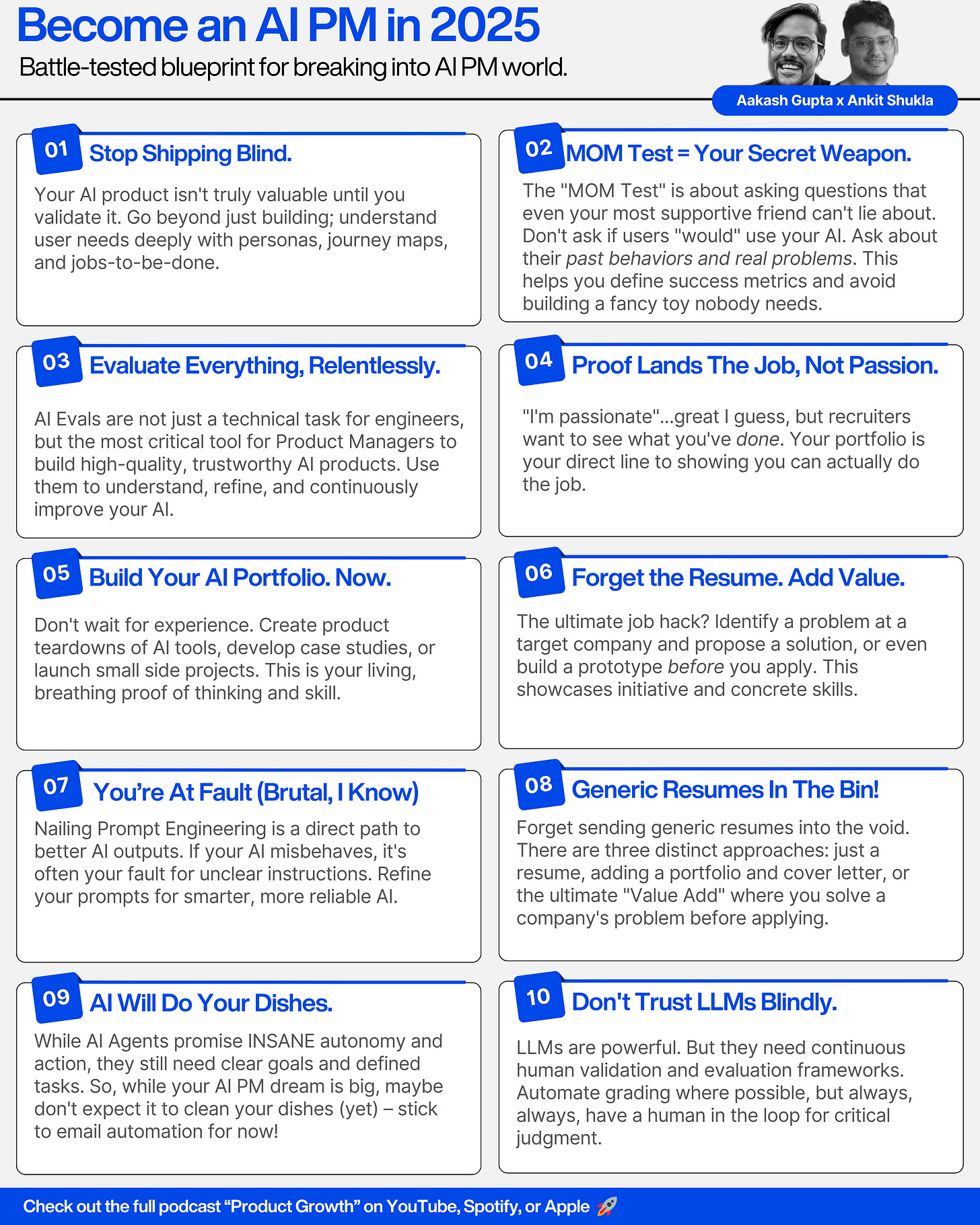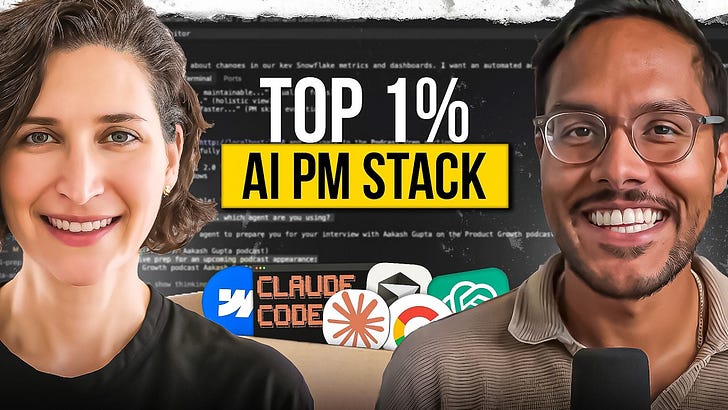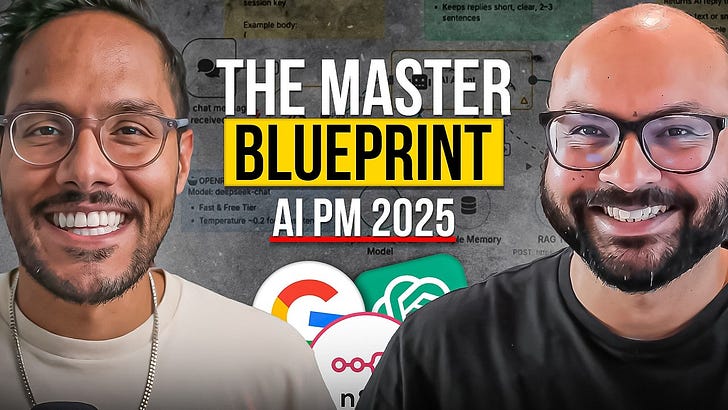Check out the conversation on Apple, Spotify and YouTube.
Brought to you by:
The AI Evals Course for PMs & Engineers: You get $800 with this link
Maven: Get $100 off my curation of their top courses
AI PM Certification: Get $500 with code AAKASH25
Today’s Podcast
I’ve done a couple different guides on becoming an AI PM recently.
But this one focuses on a few different aspects:
The KNOWLEDGE to become an AI PM
The ROADMAP to get there
I’ve brought on the wonderful Ankit Shukla, who has placed 100s of AI PMs in the world’s best organizations. And he is a magnificent teacher.
In this episode, he breaks out the iPad whiteboard to give a masterclass in what you need to know to become an AI PM.
If you only have 80 minutes this week, watch this video and you’ll walk away with everything you need to become an AI PM and increase your compensation & value.
(By the way, I recently compiled all my AI podcasts and an MBA level roadmap to becoming an AI PM. I think you’ll love this: Free PM MBA: Roadmap to PM & AI Mastery.)
Your Newsletter Subscriber Bonus:
For subscribers, each episode I also write up a newsletter version of the podcast. Thank you for having me in your inbox.
(By the way, we’ve launched our podcast clips channel as well and we’re going to post most valuable podcast moments on this channel, so don’t miss out: check channel here)
The Journey Ahead
The AI PM Spectrum
Marty Cagan’s 4 Big Product Risks
The Gold Standard: Truly Understanding Your AI User
Building blocks of building an AI product
Contextualize your AI
The Secret Sauce for Better AI (Hint: AI Evals)
The Rise Of AI Agents
Recruiters Are Yawning When You Say this…
Your Golden Ticket And Pathway To Becoming An AI PM
1. The AI PM Spectrum
The world of AI PMs has evolved.
It’s not just one role, but a spectrum.
Knowing where you land helps define your path.
There are two main categories:
AI Enabled PMs:
What they do: These PMs use AI tools to supercharge their existing product work.
Tools: Think using ChatGPT, Lovable, or NotebookLM for market research, content generation, or data analysis.
The takeaway: They leverage AI to become better traditional PMs.
(I wrote a detailed deep dive on how to become AI-powered/enabled PMs, get it here: The AI PM's Playbook: How Top Product Managers Are 10x-ing Their Impact in 2025)
AI Product PMs:
What they do: These PMs are directly involved in building AI-powered products.
→ They split into two powerful sub-categories:
Core AI PMs: They build the foundational AI components. Think working on LLMs themselves, or core infrastructure like Vector Databases. (e.g., Vertex.ai, Pinecone, directly on GPT models).
Applied AI PMs: They build products that use existing AI to solve specific user problems. This is where most user-facing AI products live. (e.g., Notion AI, Grammarly, products using ChatGPT).
2. Marty Cagan’s 4 Big Product Risks
Building great products has timeless rules, even with AI.
Marty Cagan's wisdom still shines bright for AI PMs. It all boils down to mastering four critical dimensions.
Miss one, and… your AI product might just fall flat.
Valuable (The Ultimate Win): Does it solve a genuine, burning problem for your users?
Feasible: Can your team actually build this within reasonable constraints?
Usable: Can real people use it effortlessly?
Viable: Does it make solid business sense?
Think costs, revenue, and how it fits into your company’s big game plan.
My take: I know it’s SO TEMPTING to get caught up in the AI hype. But grounding your work in these four pillars ensures you’re building something meaningful, not just “technically impressive.”
(We had Marty on the podcast as well where he shares everything you probably don’t know about product management, watch it here.)
3. The Gold Standard: Truly Understanding Your AI User
What makes an AI product indispensable?
It starts and ends with the user.
For researchers, for example, the core desires are powerful and clear.
They want AI to be a direct pipeline to breakthroughs:
Accelerate Research: Imagine slashing weeks of work into mere hours. That’s AI's promise.
Verify AI Insights: Trust is everything. Users need to check the sources behind LLM-generated content.
Choose & Test Models: No one-size-fits-all. Flexibility to pick the best AI model is crucial for tailored results.
Here’s how we DIG UP our user’s ACTUAL needs?
User Personas & ICPs: Know who you're building for, down to their core motivations.
Customer Journey Maps: Walk in their shoes. Where are the friction points?Where can AI create pure delight?
Jobs to be Done: Go beyond features. What's the real job your AI is hired to do?
MOMs Test (Measures of Success): This is your AI’s true north.
How will you truly know your AI product has moved the needle?
What metrics or changes in user behavior signify a win?
The "MOM Test" is about asking questions that even your most supportive friend can't lie about.
It pushes you to ask about past behaviors and concrete problems, not hypothetical future desires.
You can have the most advanced AI in the world, but if it doesn't solve a real human problem, it's just a fancy toy.
(This deep dive is your answer to the most important question - Am I building AI products right?: Most People are Building AI Products Wrong - Here's How to do it Right)
4. Inside the Machine: Deconstructing the AI Product Engine
Ever peeked under the hood of an AI product?
It's not just a single, mystical black box.
It's a meticulously engineered system, built from several interconnected components.
Understanding this structure is non-negotiable for any AI PM.
Here’s your blueprint to the essential layers:
Models: The brain of the operation. This includes foundational models, fine-tuned versions, or custom builds (think Grok, OpenAI).
Data Layer: The fuel that feeds the brain. This means robust collection, meticulous cleaning, precise labeling, secure storage, and constant, real-time updating.
Infrastructure: The power grid that runs it all. Consider compute power, hosting, continuous monitoring, and workflow orchestration (Nvidia, AWS SageMaker are key players).
User Interface: The face of your product. It’s about creating seamless visualizations, providing clear guidance, and designing for AI’s unique, often indeterminate, nature (Perplexity is innovating here).
Trust, Security & Feedback: The guardrails and listening posts. This means implementing strong safeguards, building user feedback loops, and creating rigorous evaluation systems.
Prompt Engineering: This is the art of conversation with AI. This layer focuses on designing effective prompts, constantly evaluating outputs, and refining instructions for optimal results. Learn prompt engineering from OpenAI’s head of product: Prompt Engineering in 2025: The Latest Best Practices
Business Layer: The strategic compass. Defining clear OKRs, tracking key metrics, ensuring alignment with company strategy, mastering monetization, and meticulously managing costs.
5. Contextualize your AI
Imagine equipping your AI with instant access to your private, up-to-the-minute knowledge base.
That's the magic of Retrieval Augmented Generation (RAG).
It lets LLMs be incredibly smart and specific, without the immense cost and effort of traditional fine-tuning.
Here’s the powerful, practical flow:
Your Question: You type a query into your AI tool.
Smart Retrieval: Your query acts like a librarian, searching your specific knowledge sources (such as internal docs, meeting notes, project plans).
Relevant Context Found: The system pulls out only the most relevant snippets from your data.
AI Gets Smarter: These precise snippets are then added directly to your original question, creating an "enhanced prompt".
Tailored Answer: The AI model uses this rich, personalized context to generate a highly accurate and relevant response.
But should you only use RAG? or maybe use Fine-Tuning? or Only rely on prompts?
Get your answers here: Context Engineering Guide: Step-by-Step RAG, Fine-tuning, and Prompt Engineering
6. The Secret Sauce for Better AI
How do you know if your AI is actually working?
You evaluate it!
"Evals" are crucial for understanding, refining, and improving AI models and products.
They provide the feedback loop necessary for continuous improvement.
Think about a practical use case: a tool that helps job seekers.
Process: It crawls recent job descriptions, enhances them with LLMs and custom context. This generates summaries, interview questions, skills needed, learning guides, and even quizzes.
The Eval Loop: The output from this process then feeds directly back into an "Eval" system. This could mean:
User feedback: Did the summary help? Were the questions relevant?
Automated checks: Does the output meet quality standards? Is it free of hallucinations?
Comparison: How does it perform against a human expert?
This constant evaluation loop helps refine the AI's prompts, its RAG process, and ultimately, its usefulness.
THIS is how AI products get better, faster.
If you want to learn AI evals from the experts, just check out these 2 resources with Hamel and Shreya Shankar:
Newsletter: AI Evals: Everything You Need to Know to Start
Podcast: The PM’s Role in AI Evals: Step-by-Step
7. The Rise Of AI Agents
What happens when AI moves beyond just answering questions and starts taking action?
That's the exciting, and frankly, mind-blowing world of AI Agents. This isn't just a passive tool you ask questions to; this is AI getting off the couch and doing stuff.
The formula is simple, yet powerful:
Intelligence + Action + Autonomy = AI AGENTS
Intelligence: The AI's ability to understand and reason.
Action: The AI's capability to do things in the real world (e.g., send emails, update systems, order products).
Autonomy: The AI's ability to operate without constant human supervision, making decisions to achieve a goal. It's like having a super-smart intern who never needs a coffee break.
Companies like Agent.ai, Zapier, and n8n are at the forefront of this, building platforms that allow AI to automate complex workflows and act as virtual team members.
We built live AI agents with many AI leaders:
(Also, in the next podcast episode, we’re building agents with the Lindy’s (popular AI agents building platform) CEO, Flo Crivello. Stay tuned for it!)
8. Recruiters Are Yawning When You Say this…
"I'm Passionate!" (Said Every Aspiring AI PM Ever)
Ever been in a job interview and felt like this?
You're probably thinking: "YES! That's me!"
We're all passionate about AI. We see the future, we want to build it.
But here's a little secret recruiters won't tell you (but secretly think):
"Okay, but can you actually do the job?"
Passion is great for waking up on Monday, but hiring managers are looking for proof. They want to reduce their risk.
They need to see that you can walk the talk, not just… talk the talk.
So, how do you bridge that gap between "passionate" and "proven"? It's simpler than you think, but it requires action. This is where your AI PM journey really begins.
Your Golden Ticket To Becoming An AI PM
If you want to become an AI Product Manager, sending a resume and hoping ain’t going to cut it.
It’s about proving your capabilities and minimizing risk for hiring managers.
This strategic approach is your UNFAIR ADVANTAGE ↴
There are three ways to showcase your skills. Choose wisely:
Just Your Resume: Simply send your CV. Easiest for you, but often the least effective. It's tough to stand out, especially without direct AI PM experience.
Resume + Cover Letter + Portfolio: Improve your application with a robust portfolio. This is where you truly shine! Your portfolio isn't just a list, it's LIVING, BREATHING proof of your thinking.
Include:
Product Teardowns: Break down existing AI products, analyze their strengths, & suggest improvements.
Case Studies: Detail how you'd apply AI PM principles to real-world problems.
Side Projects: Build something, even if it is small! Focus on why you built it, user feedback, and iterations.
9. The "Ultimate Value Add" (Your Secret Weapon)
Proactively deliver value to a company before you even apply.
This is the hardest, but most impactful strategy.
Target Smart: Pick 15-20 small-to-medium AI companies (skip the giants at first).
Strategize: Imagine you're their PM. What would you build or recommend in your first 6-8 months?
Execute & Present: Draft a roadmap, build a prototype, or outline a detailed feature for them.
Follow Up: Get it in front of key decision-makers. Persistence is key here.
If you found this newsletter valuable, you’d love the YT podcast even more as you’ll get to see the real-time conversation and Ankit explaining the concepts in depth.
Click here to get access to the FULL slide-deck.
Key Takeaways
Where to find Ankit Shukla
If you prefer to only get newsletter emails, unsubscribe from podcast emails here.
If you want to advertise, email productgrowthppp at gmail.
Related
Podcasts:
Newsletters:
P.S. More than 85% of you aren't subscribed yet. If you can subscribe on YouTube, follow on Apple & Spotify, my commitment to you is that we'll continue making this content better.



